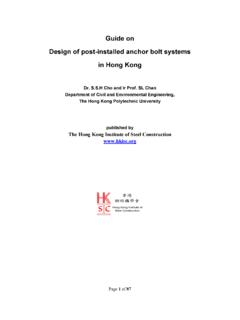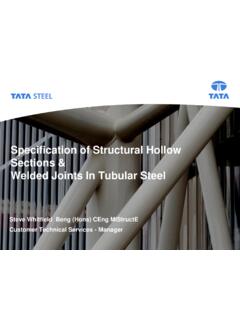Transcription of Basic structural design considerations and properties of ...
1 144 Basic structural design considerations and properties of glass and aluminum structures Chan Research Center for Advanced Technology in structural Engineering (RCATISE) Department of Civil and structural Engineering, Hong Kong Polytechnic University Synopsis A short review for design consideration of two common materials used in facade and curtain walling is presented. The characteristics of light-weight facade enveloping a building are different from the conventional steel or concrete structures. Glass cannot crack like concrete and it is much more brittle than steel. Aluminum involves many buckling modes similar to but more common than steel. Owing to the low Young modulus of elasticity around 1/3 of steel, buckling and large deflection nonlinear effects are important consideration in their design .
2 This note summaries the most fundamental features of structures made of these materials. Keywords: glass, aluminum, buckling, structural design , nonlinear analysis, design codes, breakage. 145 Introduction Glass is a brittle material that is weak in tension because of its non-crystalline molecular structure. When glass is stressed beyond its strength limit, breakage occurs immediately without warning, unlike steel and aluminum where plastic mechanism can be formed. Stress or moment re-distribution does not occur in glass and local and then consequential global failure is very common in glass. Testing has shown that glass strength is statistical in nature. Highly stressed and larger stressed area results in a higher probability of failure.
3 Stress vs strain curves for steel and glass Damage of glass panels during typhoon In spite of the structural shortcoming of glass, its use is unavoidable since they are transparent and aesthetic and can be tailor-made in shape and color to suit various architectural purposes. We can see that most award-winning projects overseas contain heavy glass ingredient. Glass was developed 4000 years ago. In early this century, sheet glass was invented by drawing glass ribbon vertically out of the molten glass pool. It is distorted because of various viscosity of molten glass. In 1959, float glass was introduced. Glass ribbon is pulled through a tin bath and exit on rollers through an annealing lehr where it is cooled.
4 Rolled glass is made by passing molten glass from a furnace through a series of rolls. It is used for wired glass and patterned glass. However, most common glass used to-day is float glass. 146 The float glass manufacturing process For conventional glass panels under heat-treatment for strength improvement, structurally they can be classified into 3 groups as annealed, heat-strengthened and tempered glass. As glass is a brittle material that stress cannot be re-distributed and failure is assumed once crack occurs, the failure stress can only be referred as a probability of failure. The following permissible stress will contain a probability of failure of for annealed glass. Also, as a brittle material, glass is failed theoretically by tension only and its compressive stress is extremely large.
5 The quoted stress is 800 N/mm2 (St. Gobain Glass Manufacturer). MTR entrance in Japan Damage of high-rise buildings in Hong Kong during visit of typhoon York 147 Stresses in glass used in various national design codes Six national codes have been reviewed. They are the , , Australia, Canada, China and Japan. In Japan, they normally use the manufacturer data and the code does not provide stress value. In , the Piklkington glass recommendation is used since BS does not provide this value. In Canada , they give detailed stress value. Whilst the charts in are similar to the Canadian one, they are based on the same stress. In Australian and Chinese codes, explicit stress is given. They are tabulated as follows.
6 Typical properties for glass Weight = 2500 kg/m3 Young s modulus of elasticity = 70 kN/mm2 Shear modulus of elasticity (G) = 30 kN/mm2 Poisson s ratio = Coefficient of thermal expansion = Permissible deflection (from Australia standard) = structural span/60 Deflection is very important as complaints are always due to excessive deflections. Deflection of glass panels under design pressure (Note the reflection) 148 All units below are in N/mm2 : t = thickness of glass plate Glass Type Canada1/ Australian3 Chinese5 Load duration 60 seconds 3 seconds 3 seconds 60 seconds Load factor 1. 1. Annealed 20/25 (edge/center, following similar) 20 41 for t 6 for t 8 28 for t 10 28 for 5<t<12 20 for 15<t<19 Heat-strengthened 40/50 32 - - Tempered 80/100 50 59 84 for 5<t<12 59 for 15<t<19 1.
7 Canadian General Standards Board (1989), structural design of glass for buildings , The first one refers to centre stress and the second one to edge stress. 2. ASTM (1997), Standard practice for determining minimum thickness and type of glass required to resist a specified load, E1300-97. 3. Standards Australia (1994), Glass in buildings selection and installation . 4. Pilkington Glass (see IStructE, structural Use of glass in buildings, 1999) 5. Technical Code for Glass Curtain Wall Engineering , JGJ 102-96, 1996, Beijing, China NOTE: For probability of failure in annealed glass, a design factor of is used against the averaged stress. For of failure, the design factor is 5. For sloped glazing, the failure probability of failure is commonly used.
8 Glass strength is time dependent and these countries use different load duration.( for a 4-side simply supported glass plate, we havetRRt151minute 1 =where R is the pressure and t is the load duration.) 149 design procedure for thickness of glass panes 1 Determine the shape and size of glass panes 2 Assume boundary conditions along each side of the glass pane ( point-supports, 4-side, 3-side or 2 side support) 3 Check the supports for the pane are not deforming too much ( they would not deform more than span/180). Otherwise strengthen the support or assume a more conservative boundary conditions. 4 Assess loads and load type. Magnitude and duration of loads are estimated. 5 Compute stress ( ) and deflection ( ) of glass pane by a Nonlinear Finite Element software and check against maximum stress for glass type and glass deflection (see stress for edge or center locations and for short or long term loads in Table above and glass pane deflection should generally be less than structural span/60).
9 Non-linear large deflection theory reflects more accurately the actual behaviour of a glass pane which behaves nonlinearly. For regular shaped glass panels, design charts are available. 6 Determine glass thickness 7 Detailing against stress concentration, fabrication, water leakage etc. 8 Check practicality and study safety The reason why nonlinear theory predicts less deflection which is closer to experimental result is due to the membrane action. As the central point deflects, the material on the four sides with less deflection restrains the centre movement and thus the deflection is less. The detailed explanation can be found in the paper by So, Lai and Chan (2002). Nonlinear Large Deflection and Linear small deflection theory 150 The design charts by linear and non-linear analyses in ASTM (Upper one is linear, lower one is non-linear) 151 Linear vs.
10 Non-linear analysis Nonlinear analysis is not popular in Hong Kong, because of at least two main reasons as follows. 1. Nonlinear analysis for frames checks P- and P- effects and therefore the related buckling modes will not be missed. Linear analysis produces prediction for higher load resistance as it does not consider all possible buckling modes. Unfortunately, many analysts said angrily Why I have no problem in designing my structure by my old software and now the structure is detected by a new nonlinear analysis as unsafe ? Nonlinear analysis is no good to my project .. until the following happens but it becomes too late . 2. The users are not familiar with nonlinear analysis at all.





